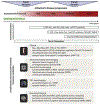Therapy for Alzheimer's disease: Missing targets and functional markers?
- PMID: 33711510
- PMCID: PMC8131215
- DOI: 10.1016/j.arr.2021.101318
Therapy for Alzheimer's disease: Missing targets and functional markers?
Abstract
The development of the next generation therapy for Alzheimer's disease (AD) presents a huge challenge given the number of promising treatment candidates that failed in trials, despite recent advancements in understanding of genetic, pathophysiologic and clinical characteristics of the disease. This review reflects some of the most current concepts and controversies in developing disease-modifying and new symptomatic treatments. It elaborates on recent changes in the AD research strategy for broadening drug targets, and potentials of emerging non-pharmacological treatment interventions. Established and novel biomarkers are discussed, including emerging cerebrospinal fluid and plasma biomarkers reflecting tau pathology, neuroinflammation and neurodegeneration. These fluid biomarkers together with neuroimaging findings can provide innovative objective assessments of subtle changes in brain reflecting disease progression. A particular emphasis is given to neurophysiological biomarkers which are well-suited for evaluating the brain overall neural network integrity and function. Combination of multiple biomarkers, including target engagement and outcome biomarkers will empower translational studies and facilitate successful development of effective therapies.
Keywords: Alzheimer’s disease; Clinical trials; Drug development; Non-pharmacological treatment; Novel biomarkers.
Copyright © 2021 Elsevier B.V. All rights reserved.
Conflict of interest statement
Declarations of interest:
Dr. Mihály Hajós is an employee of Cognito Therapeutics, shareholder of Biogen and Pfizer. The other authors have no conflicts of interest.
Figures


Similar articles
-
PTI-125 Reduces Biomarkers of Alzheimer's Disease in Patients.J Prev Alzheimers Dis. 2020;7(4):256-264. doi: 10.14283/jpad.2020.6. J Prev Alzheimers Dis. 2020. PMID: 32920628 Clinical Trial.
-
Tau biomarkers in Alzheimer's disease: towards implementation in clinical practice and trials.Lancet Neurol. 2022 Aug;21(8):726-734. doi: 10.1016/S1474-4422(22)00168-5. Epub 2022 May 25. Lancet Neurol. 2022. PMID: 35643092 Review.
-
Core candidate neurochemical and imaging biomarkers of Alzheimer's disease.Alzheimers Dement. 2008 Jan;4(1):38-48. doi: 10.1016/j.jalz.2007.08.006. Epub 2007 Dec 21. Alzheimers Dement. 2008. PMID: 18631949 Review.
-
Understanding disease progression and improving Alzheimer's disease clinical trials: Recent highlights from the Alzheimer's Disease Neuroimaging Initiative.Alzheimers Dement. 2019 Jan;15(1):106-152. doi: 10.1016/j.jalz.2018.08.005. Epub 2018 Oct 13. Alzheimers Dement. 2019. PMID: 30321505 Review.
-
Biomarkers in Alzheimer's disease drug development.Alzheimers Dement. 2011 May;7(3):e13-44. doi: 10.1016/j.jalz.2010.06.004. Epub 2011 May 6. Alzheimers Dement. 2011. PMID: 21550318 Review.
Cited by
-
Genetic Inactivation of Free Fatty Acid Receptor 3 Impedes Behavioral Deficits and Pathological Hallmarks in the APPswe Alzheimer's Disease Mouse Model.Int J Mol Sci. 2022 Mar 24;23(7):3533. doi: 10.3390/ijms23073533. Int J Mol Sci. 2022. PMID: 35408893 Free PMC article.
-
Patchouli alcohol as a selective estrogen receptor β agonist ameliorates AD-like pathology of APP/PS1 model mice.Acta Pharmacol Sin. 2022 Sep;43(9):2226-2241. doi: 10.1038/s41401-021-00857-4. Epub 2022 Jan 28. Acta Pharmacol Sin. 2022. PMID: 35091686 Free PMC article.
-
Synaptic Secretion and Beyond: Targeting Synapse and Neurotransmitters to Treat Neurodegenerative Diseases.Oxid Med Cell Longev. 2022 Jul 25;2022:9176923. doi: 10.1155/2022/9176923. eCollection 2022. Oxid Med Cell Longev. 2022. PMID: 35923862 Free PMC article. Review.
-
Identification of potential targets of cinnamon for treatment against Alzheimer's disease-related GABAergic synaptic dysfunction using network pharmacology.Sci Rep. 2022 Nov 19;12(1):19959. doi: 10.1038/s41598-022-24378-0. Sci Rep. 2022. PMID: 36402912 Free PMC article.
-
Research trend of microbiota-gut-brain axis in Alzheimer's disease based on CiteSpace (2012-2021): A bibliometrics analysis of 608 articles.Front Aging Neurosci. 2022 Nov 22;14:1036120. doi: 10.3389/fnagi.2022.1036120. eCollection 2022. Front Aging Neurosci. 2022. PMID: 36483116 Free PMC article.
References
-
- Adolfsson O, Pihlgren M, Toni N, Varisco Y, Buccarello AL, Antoniello K, Lohmann S, Piorkowska K, Gafner V, Atwal JK, Maloney J, Chen M, Gogineni A, Weimer RM, Mortensen DL, Friesenhahn M, Ho C, Paul R, Pfeifer A, Muhs A, Watts RJ, 2012. An effector-reduced anti-beta-amyloid (Abeta) antibody with unique abeta binding properties promotes neuroprotection and glial engulfment of Abeta. J Neurosci 32, 9677–9689. - PMC - PubMed
-
- Almkvist O, Jelic V, Amberla K, Hellstrom-Lindahl E, Meurling L, Nordberg A, 2001. Responder characteristics to a single oral dose of cholinesterase inhibitor: a double-blind placebo-controlled study with tacrine in Alzheimer patients. Dement Geriatr Cogn Disord 12, 22–32. - PubMed
-
- Alzheimer’s Association, 2020. 2020 Alzheimer’s disease facts and figures. Alzheimers Dement 16, 391–460. - PubMed
Publication types
MeSH terms
Substances
Grants and funding
LinkOut - more resources
Full Text Sources
Other Literature Sources
Medical

